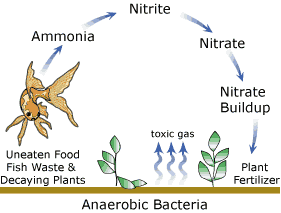All Articles, Water Testing
Water Testing – Ammonia
 Ammonia is extremely harmful to pond life and is constantly produced from fish waste, urine, uneaten food and decaying algae or plant matter. There is no safe level of Ammonia in ponds, even if the level is quite low it will be effecting your fish. Ammonia is converted to nitrite, which is also harmful to fish, then to harmless nitrate by the biological good bacteria found in ponds. Ammonia can build up because of a number of reasons. These include:
Ammonia is extremely harmful to pond life and is constantly produced from fish waste, urine, uneaten food and decaying algae or plant matter. There is no safe level of Ammonia in ponds, even if the level is quite low it will be effecting your fish. Ammonia is converted to nitrite, which is also harmful to fish, then to harmless nitrate by the biological good bacteria found in ponds. Ammonia can build up because of a number of reasons. These include:
- The first few months setting up a pond. Many people want to fill the pond up and put the fish in straight away. This can be harmful as there is no bacteria in the pond to help break down their waste. It is recommended to fill up your pond, dose with chlorine neutralizer (if using tap water) and bacteria, then wait a week or two before putting fish in. This bacteria will need to be put in the pond every week for the first month. Getting this good Bacteria in your pond is strongly recommended as it can take months or years for the bacteria to naturally build-up to a sustainable level.
- Build-up of debris in the bottom of the pond or filters. If the pond filter has been left to its own devices for far too long or the pond has a massive build-up on the bottom, this can contribute to a rise in ammonia levels as there may not be enough bacteria or the bacteria may not be able to keep up with the breakdown of this matter.
- Two many fish in the pond. If your pond is overcrowded the bacteria won't be able to keep up with the amount of waste being created.
- Using Rainwater. Rainwater can be quite SOFT, meaning it lacks a lot of calcium and magnesium, which is what the good bacteria needs to thrive. If the bacteria can't colonize properly it can't break down the debris. We recommend testing your Carbonate Hardness levels when using rain water.
Ammonia is colourless and has no smell, so if you have a large amount of build-up in your pond and a foul-smell this is generally a sign that you don't have enough oxygen and have no good bacteria and instead the anaerobic (doesn't need oxygen to survive) bacteria is trying to do the job but at a slower pace and producing that terrible rotten egg smell. Signs that may show you have high Ammonia levels are:
- Burns on fins or gills.
- Fish gasping for air at the surface of the water. The build-up of Ammonia affects the gill function of the fish so that they cannot excrete the Ammonia and prevents red blood cells from taking up vital oxygen.
- Lethargic Behaviour
- No appetite. If they are not eating their food it should be removed from the pond.
- Sitting on the bottom of the pond.
Generally when fish are looking ill the first thing you do is a water test to establish the cause. You can test the Ammonia levels with the PondCare Master Test Kit, which also has Nitrite, Phosphate and pH tests included or you can buy the Ammonia Test Kit separately. To treat high levels of Ammonia you should:
- Do a partial water change (25%). Make sure to use a Chlorine neutralizer when you are filling the pond back up. Using Stress Coat is ideal as it contains added benefits.
- Add Beneficial Bacteria. You can use either PondMax Clarifier Bacteria. To get the bacteria to thrive quicker you can also add The Water Cleanser Block to your pond. This wax block is designed to help keep your water crystal clear but it will also provide the bacteria with an area to colonize and thrive in.
You can drop in to The Pond Shop with a water sample and we can perform a Water Test for just $5.00. If you have any concerns or would like to speak to someone about a particular problem you are having with your pond you can send us an e-mail, give us a call or come and speak with us in the shop.
